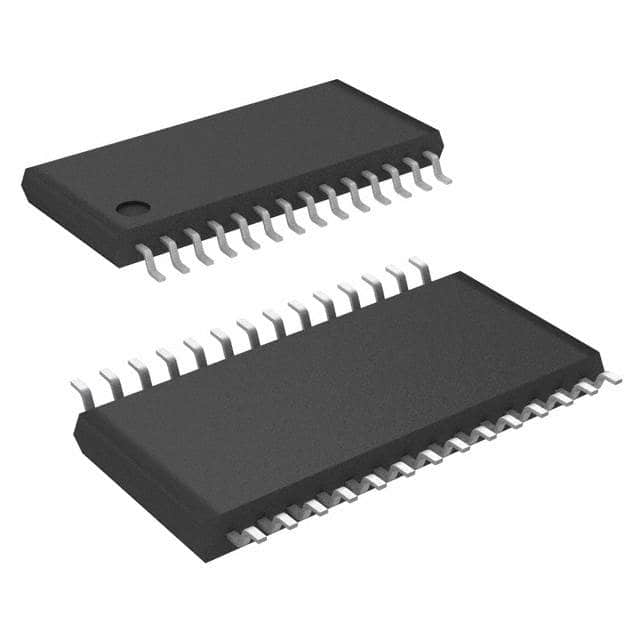Viz Specifikace pro podrobnosti o produktu.

AD7193BRUZ
Product Overview
Category
AD7193BRUZ belongs to the category of integrated circuit (IC) chips.
Use
The AD7193BRUZ is commonly used in precision analog-to-digital converters (ADCs).
Characteristics
- High resolution: The AD7193BRUZ offers a high resolution of up to 24 bits.
- Low noise: It provides low noise performance, ensuring accurate conversion of analog signals.
- Low power consumption: The chip is designed to consume minimal power, making it suitable for battery-powered applications.
- Flexible input options: The AD7193BRUZ supports various input configurations, including differential and single-ended modes.
- On-chip features: It includes on-chip programmable gain amplifiers (PGAs), reference buffers, and voltage regulators.
Package
AD7193BRUZ is available in a small outline integrated circuit (SOIC) package.
Essence
The essence of AD7193BRUZ lies in its ability to convert analog signals into digital data with high precision and low noise.
Packaging/Quantity
The AD7193BRUZ is typically packaged in reels or tubes, with a quantity of 250 units per reel/tube.
Specifications
- Resolution: Up to 24 bits
- Input voltage range: ±VREF
- Sampling rate: Up to 4.8 kSPS (kilosamples per second)
- Power supply: 2.7 V to 5.25 V
- Operating temperature range: -40°C to +105°C
Detailed Pin Configuration
The AD7193BRUZ has a total of 28 pins. The pin configuration is as follows:
- AVDD: Analog power supply
- DVDD: Digital power supply
- AGND: Analog ground
- DGND: Digital ground
- AIN1(+) / AIN1(-): Differential analog input 1
- AIN2(+) / AIN2(-): Differential analog input 2
- REFOUT: Reference voltage output
- REFIN: Reference voltage input
- VBIAS: Bias voltage output
- VIO: Digital I/O supply voltage
- SDO: Serial data output
- SDI: Serial data input
- SCLK: Serial clock input
- CS: Chip select input
- RDY: Data ready output 16-28. NC: No connection
Functional Features
1. High-resolution ADC
The AD7193BRUZ offers a high resolution of up to 24 bits, enabling precise conversion of analog signals into digital data.
2. Programmable Gain Amplifiers (PGAs)
On-chip PGAs allow for flexible signal conditioning and amplification, enhancing the versatility of the ADC.
3. Low Noise Performance
The chip is designed to provide low noise performance, ensuring accurate conversion even in noisy environments.
4. Flexible Input Options
AD7193BRUZ supports various input configurations, including differential and single-ended modes, providing flexibility for different applications.
Advantages and Disadvantages
Advantages
- High resolution enables accurate conversion of analog signals.
- Low noise performance ensures reliable data acquisition.
- Flexible input options cater to diverse application requirements.
- On-chip features reduce the need for external components.
Disadvantages
- Limited sampling rate compared to some other ADCs on the market.
- Higher power consumption compared to lower-resolution ADCs.
Working Principles
The AD7193BRUZ operates based on the principle of successive approximation. It samples the analog input signal, digitizes it using an internal ADC, and provides the digital output.
Detailed Application Field Plans
The AD7193BRUZ is widely used in various applications, including but not limited to: - Industrial process control - Weighing scales - Medical instrumentation - Data acquisition systems - Temperature measurement devices
Detailed and Complete Alternative Models
Some alternative models to AD7193BRUZ include: - AD7791: A lower-resolution ADC with similar features. - ADS124S08: A higher-resolution ADC with differential input options. - MCP3424: A cost-effective ADC with programmable gain amplifiers.
These alternative models offer different trade-offs in terms of resolution, input options, and cost, allowing users to choose the most suitable option for their specific application.
Word count: 525 words
Seznam 10 běžných otázek a odpovědí souvisejících s aplikací AD7193BRUZ v technických řešeních
Sure! Here are 10 common questions and answers related to the application of AD7193BRUZ in technical solutions:
Q: What is the AD7193BRUZ? A: The AD7193BRUZ is a low-noise, low-power, 24-bit analog-to-digital converter (ADC) designed for precision measurement applications.
Q: What is the input voltage range of the AD7193BRUZ? A: The AD7193BRUZ has a programmable input voltage range from ±VREF/2 to ±VREF.
Q: What is the maximum sampling rate of the AD7193BRUZ? A: The AD7193BRUZ can achieve a maximum sampling rate of 4.8 kSPS (thousand samples per second).
Q: Can the AD7193BRUZ operate with both single-ended and differential inputs? A: Yes, the AD7193BRUZ supports both single-ended and differential inputs, providing flexibility in various measurement scenarios.
Q: Does the AD7193BRUZ have built-in digital filters? A: Yes, the AD7193BRUZ features an on-chip digital filter that can be configured to optimize noise performance and settling time.
Q: What is the power supply voltage range for the AD7193BRUZ? A: The AD7193BRUZ operates with a power supply voltage range of 2.7 V to 5.25 V.
Q: Can the AD7193BRUZ interface directly with microcontrollers or processors? A: Yes, the AD7193BRUZ has a serial interface (SPI) that allows direct communication with microcontrollers or processors.
Q: Does the AD7193BRUZ have a built-in reference voltage source? A: No, the AD7193BRUZ requires an external reference voltage source for accurate measurements.
Q: Can the AD7193BRUZ be used in low-power applications? A: Yes, the AD7193BRUZ has a low-power mode that reduces power consumption during idle periods.
Q: What are some typical applications of the AD7193BRUZ? A: The AD7193BRUZ is commonly used in precision weighing scales, industrial process control, medical instrumentation, and scientific research applications.
Please note that these answers are general and may vary depending on specific implementation requirements.

